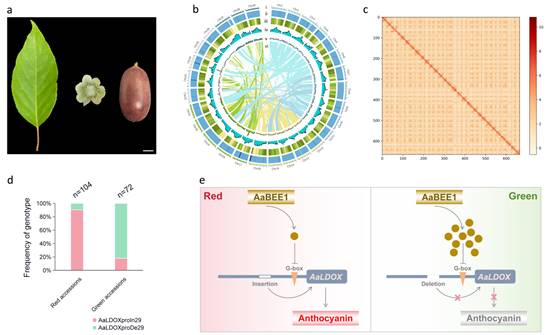Actinidia arguta (kiwifruit) looking like red ruby always attract customers’ attention in the dazzling fruit market. In recent years, this mini-typed kiwifruit with smaller fruit size and more smooth peel recently is becoming the new favorite because of its unique red fruit.
Recently, Group of Kiwifruit Genetic Resources and Improvement of Zhengzhou Fruit Research Institute of Chinese Academy of Agricultural Sciences published paper in ‘Molecular Horticulture’ that assemble the near complete genome of the first whole-red-typed tetraploid A. arguta, and identify AaBEE1-AaLDOX color regulation module, unveiling the mystery of red fruit, laying the foundation for kiwifruit color improvement.
The ‘Tianyuanhong’ with excellent fruit quality was selected as the material for sequencing. Differing with diploid Actinidia chinensis, this tetraploid A. arguta contains four sets of chromosomes in one cell, and the genome complexity is comparable to a maze. Scientists assembled disorganized genetic fragments into a complete genome using PacBio HiFi and Hi-C sequencing technology.
Through comparative genome analysis, researchers found A. arguta has experienced the contraction/expansion of specific gene families that lead to the symbolic A. arguta fruits. After then scientists focused on two key genes, AaBEE1 and AaLDOX, which form a sophisticated 'color switch system'.
AaBEE1 was proved to be as the negative regulator: overexpression of AaBEE1 in model plants could cause discoloration in Arabidopsis and tomatoes, and whiten the red petals in tobacco. Based on the DAP-seq results, researchers found AaBEE1 could specifically bind to the G-box motif in the AaLDOX promoter, thus inhibiting the expression of AaLDOX.
The 29 bp InDel variation located at AaLDOX promoter is the key factor determining whether the fruit color or not. In green A. arguta, this 29 bp deletion reduces the activity of AaLDOX promoter, and coupled with the inhibition of AaBEE1 on the activity of the AaLDOX promoter, leading to the double suppression on anthocyanin synthesis. In red A. arguta, there is no this double suppression effect. This intricate regulatory mechanism explains the significant differences of fruit color in the same species.
This breakthrough finding in the study provide the explicit target for molecular breeding. In the traditional breeding process, color identification and screening need to wait for fruit ripen that would spend long period with 5-8 years. Now the molecular detection and gene editing creation will increase breeding efficiency by over 70%.
Genome assembly and color regulation model
By Li Yukuo
liyukuo@caas.cn

